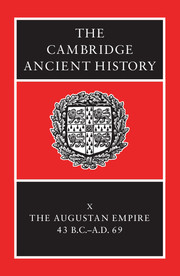14a - Greece (including Crete and Cyprus) and Asia Minor from 43 B.C. TO A.D. 69
from 14 - The East
Published online by Cambridge University Press: 28 March 2008
Summary
GEOGRAPHY AND DEVELOPMENT
The area to be dealt with here was in some senses a unity, in others, less important, diverse and falling into three regions, mainland Greece and the islands, western Asia Minor, and the Anatolian plateau. What unified it was geography – common subjection to Mediterranean geology and climatic conditions and the seasonal aridity that governs Mediterranean agriculture; language – it was all predominantly Greek-speaking; history – the entire area had come under the sway of Alexander the Great and then that of Rome; and devotion to common political ideals, those of the city-state (polis). Within these categories came also the variety. In Asia Minor the thin border of arable soil that fronts the limestone mountains of mainland Greece, the ‘bare bones’ of Attica, as Plato calls them, was being enriched and extended by accretions brought down by the rivers; to such an extent that cities such as Priene, built like most Greek cities for communication by sea, had already found themselves stranded inland; even Miletus and Ephesus were to lose their position on the coast in the end. Inland and to the east, as the mountains rise into the Anatolian plateau and then into the Taurus range, with its southern extension into Lycia and Cilicia Tracheia, a more continental type of climate takes over, with long severe winters and summers no less dry than those of Greece and the islands. Grain and the vine could be grown, but not the olive; cattle and above all sheep were the staple product, with minerals a potential source of wealth; textiles of all kinds were among the most important products of the entire peninsula.
Keywords
- Type
- Chapter
- Information
- The Cambridge Ancient History , pp. 641 - 675Publisher: Cambridge University PressPrint publication year: 1996
References
- 2
- Cited by



